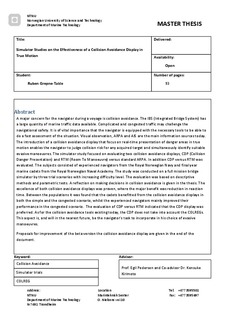Simulator Studies on the Effectiveness of a Collision Avoidance Display in True Motion
Master thesis
Permanent lenke
http://hdl.handle.net/11250/237992Utgivelsesdato
2011Metadata
Vis full innførselSamlinger
- Institutt for marin teknikk [3397]
Sammendrag
A major concern for the navigator during a voyage is collision avoidance. The IBS (Integrated Bridge System) has a large quantity of marine traffic data available. Complicated and congested traffic may challenge the navigational safety. It is of vital importance that the navigator is equipped with the necessary tools to be able to do a fast assessment of the situation. Visual observation, ARPA and AIS are the main information sources today. The introduction of a collision avoidance display that focus on real-time presentation of danger areas in true motion enables the navigator to judge collision risk for any acquired target and simultaneously identify suitable evasive manoeuvres. The simulator study focused on evaluating two collision avoidance displays, CDP (Collision Danger Presentation) and RTM (Room To Manoeuvre) versus standard ARPA. In addition CDP versus RTM was evaluated. The subjects consisted of experienced navigators from the Royal Norwegian Navy and final year marine cadets from the Royal Norwegian Naval Academy. The study was conducted on a full mission bridge simulator by three trial scenarios with increasing difficulty level. The evaluation was based on descriptive methods and parametric tests. A reflection on making decisions in collision avoidance is given in the thesis. The excellence of both collision avoidance displays was proven, where the major benefit was reduction in reaction time. Between the populations it was found that the cadets benefitted from the collision avoidance displays in both the simple and the congested scenario, whilst the experienced navigators mainly improved their performance in the congested scenario. The evaluation of CDP versus RTM indicated that the CDP display was preferred. As for the collision avoidance tools existing today, the CDP does not take into account the COLREGs. This aspect is, and will in the nearest future, be the navigator’s task to incorporate in his choice of evasive manoeuvres.
Proposals for improvement of the beta version the collision avoidance display are given in the end of the document.
